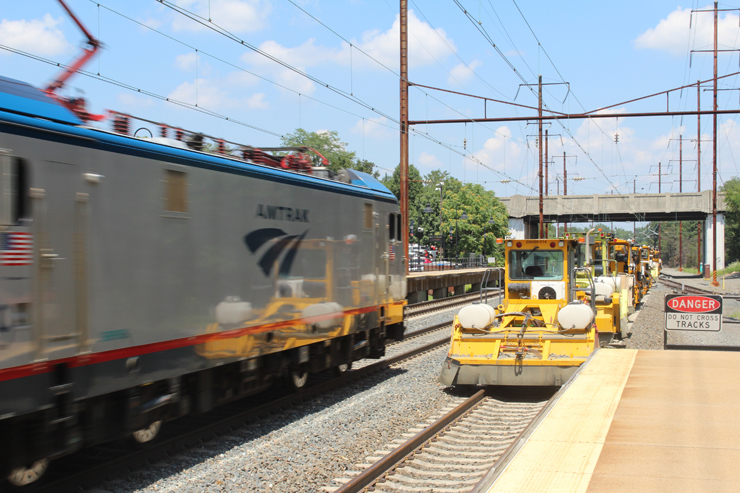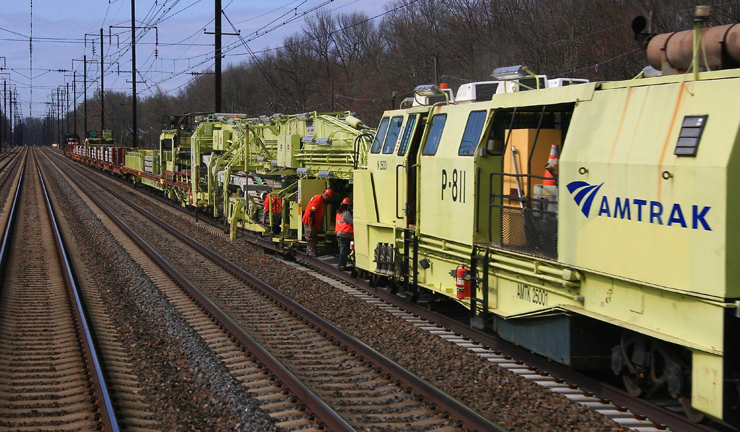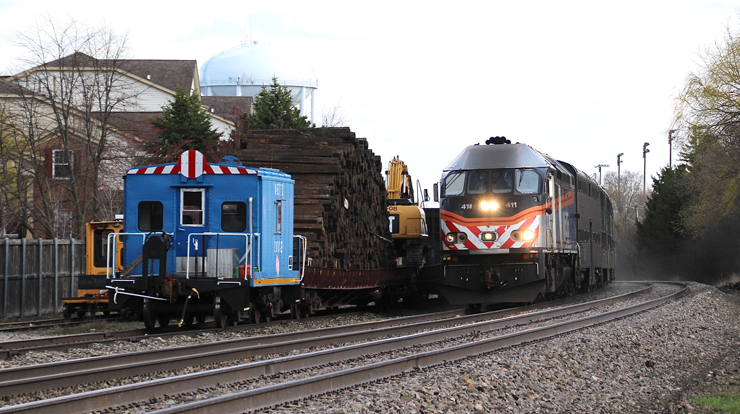The COVID-19 pandemic and associated stay-at-home orders have struck down some large rail construction projects while others are moving ahead, taking advantage of reduced train operations to accelerate work schedules.
A survey conducted in April by the National Railroad Construction and Maintenance Association (NRC) found that a quarter of its members are seeing a decrease in business, while the majority is experiencing no change. But Matt Ginsberg, who heads NRC’s management and lobbying firm, notes, “June-July is really when they’re going to have an idea of the true impact.”
Some Class I freight railroads, seeing sharp drops in carload volumes, are closing shops and yards while pulling back on planned capital expenditures. Norfolk Southern announced a $500 million cut to its 2020 capital investment program [see “Norfolk Southern to cut capital spending 25% because of downturn,” Trains News Wire, April 29, 2020].
Union Pacific will reduce spending approximately 6%. CSX is also cutting back, but Canadian Pacific says it will hold steady on its planned capital investments of $1.6 billion.
Ashley Wieland, president of the NRC, says construction crews are facing new-found challenges on the job. “There’s not a lot of hotels for the construction jobs that have people travel in, and there’s not restaurants open for them to eat at,” she says. For workers, fast food or gas station restrooms may be inaccessible.
However, Amtrak is using this time to speed up repair and maintenance projects while also saving labor costs. The railroad’s New York office provided these details to Trains News Wire:
On the Northeast Corridor:
— Crews are accomplishing 20% more Sperry rail testing at night, using extended overnight track outages to perform more testing during each shift, while reducing the cost per mile by almost 50 percent.
— Work gangs are now getting weekday time to replace switches at Hook Interlocking in Marcus Hook, Pennsylvania.
— Work is continuing, with some increased productivity, on Amtrak’s Infrastructure Renewal Program at New York’s Penn Station [See “Amtrak to resume Penn Station work Jan. 3,” Trains News Wire, Dec. 20, 2019].
Elsewhere:
— The tie gang on the Harrisburg Line now has a continuous outage on Track 1 between Fraser and Downs interlockings, giving them eight hours of uninterrupted work time per shift. The increased efficiency has more than doubled their nightly production, eliminating the need for overtime.
— Work gangs are getting weekday time to do wood tie and timber replacement at Zoo Interlocking, where SEPTA’s Paoli/Thorndale Line and Cynwyd Line joins Amtrak’s Harrisburg Line, avoiding overtime.
— More than 19 miles of rail have been replaced between New Buffalo and Galien, Mich., due to reduced traffic.
— Track surfacing gangs on the Amtrak Michigan Line improved 11,088 feet of rail in one night, while the rail gang laid 4,615 feet of rail. Service reductions have allowed the surfacing gangs to increase their nightly track outages, which allows them to surface greater sections of track at a time.
— Additional Sperry inspections have also been carried out on Amtrak-maintained routes in Michigan and Indiana.
Some transit agencies and commuter railroads are maximizing this opportunity to get more work done.
Bay Area Rapid Transit (BART) is accelerating track work, replacing 500 feet of rail a night as the system is closing 3 hours earlier on weekdays, along with reduced weekend service hours.
LA Metro expects to save six months from the construction schedule of the Purple Line subway after the city of Beverly Hills agreed to a three-block closure of Wilshire Boulevard. That will speed up work on the new Wilshire/Rodeo station and reduce disturbance to local businesses.
Metro is also taking advantage of lighter street traffic to expedite construction of the new Little Tokyo station for the downtown Regional Connector, which will link the A Line (former Blue Line) and L (Gold) Line. With reduced ridership, Metro is closing a portion of the C (Green) Line on three weekends in May and June for work on the connecting tracks to the new Crenshaw/LAX Line.
The Long Island Rail Road continues work unabated to add 10 miles of third mainline track from Floral Park to Hicksville [see “LIRR third-track project remains on schedule,” Trains News Wire, May 6, 2020]. New York State defines this project as essential construction.
Work is also ongoing for LIRR’s East Side Access program at Harold Interlocking in Queens and the new passenger concourse at Grand Central Terminal. Rails and fiber optic cables are being laid in the 63rd Street East River tunnels.
Chicago’s Metra ramped up its 2020 construction program earlier than usual to take advantage of the increased track time available while service was reduced. The 2020 program, outlined in detail here, includes construction of two new stations and replacement of a 121-year-old bridge in Chicago, as well as smaller projects on all 11 Metra lines.
The Massachusetts Bay Transportation Authority (MBTA) will enact a partial closure of the Blue Line for 14 days beginning May 18 for track replacement work. But staff shortages, the need to maintain social distancing on the job, and budget woes are taking a toll on other projects in Boston and elsewhere.
MBTA spokeswoman Lisa Battiston tells Trains News Wire that 17 of 50 active capital projects have been delayed by staffing issues related to COVID-19, resulting in setbacks up to two months.
She explains that safety-critical work continues but that some projects are being put on hold “to ensure that necessary engineering and maintenance employees can focus on providing safe service for MBTA customers, many of whom provide COVID-19 essential services.” Boston’s quarter-million health care workers often rely on the MBTA to get to work at the area’s 20 hospitals.
Lisa Trujillo, Denver Regional Transportation District project outreach manager, says that the pandemic has had no effect on construction of the N Line, which follows the I-25 corridor north. “We are moving full speed ahead,” she says. However, Colorado Public Radio reports that funding for the long-planned extension of the B Line commuter rail to Boulder and Longmont may be diverted to prevent deep cuts in current light rail and bus service.
Sound Transit halted 80% of its construction work on April 4, continuing only activities deemed critical. On April 28, Washington Gov. Jay Inslee announced that construction could resume where social distancing can be maintained and workers are equipped with personal protective equipment (PPE). Work is now underway on three light rail extension projects: the Federal Way Link, East Link, and Lynwood Link.
Across the U.S., nearly a million construction jobs were lost in April alone. NRC’s Wieland says, “We’re hoping that we can get through this pandemic and get back on track.”

















Mister Landey: I have never hung out of the dutch doors of a vestibule, so I am probably not a railfan. But I may or may not have hung out on the rear platform of old Harriman cars in the late afternoon, watching the sunset in the late afternoon, as the track receded into the distance and we smoked cigarettes and all kinds of things … not something I would ever admit without first discussing it with legal counsel and getting the resulting proffer agreement in writing …
ROBERT CALLAHAN – Your experiences (below) put you at the very top of the railfan community!!!!
All I know is that the French I learned in high school was Parisian and they don’t speak that in rural Quebec.
Hmmm. There are parts of Vermont, New Hampshire and Maine that have been French speaking, or partly so, since the days of the revolution. I imagine the French is the same a rural Quebec.
The rear vestibule of the Afternoon Congo between Trenton and Monmouth Junction in 1970 watching a Metroliner recede into the distance was another exhilarating ride. It was gone in the distance in the blink of an eye.
RICHARD – All true what you posted. The friend I was visiting in Montreal was a native French speaker from Nouveau Brunswick. Living in Montreal she felt like a foreigner.
Mr. Landey: Regarding your comment about the “French” you overheard on the Remote Service train out of Montreal, I have been told that many Quebecois (especially rural Quebecois) speak a French more akin to the French of the voyageurs of the 1700s than to “modern” contemporary French such as would be taught generally in schools in this country.
Best vestibule ride was behind a Reading T-1 through the Delaware Water Gap. Took a couple of days to get the cinders out of my hair…
Mr. Landey, would riding the head end of three Canadian Pacific freight trains (two WB, one EB), between the CP’s Alyth Yard in Calgary, AB, and the Division point of Field, BC, qualify me as a railfan (not a “foamer”. I abhor the term.)? Those trips would have been along the Bow River, by “Morant’s Curve”, through Banff and Lake Louise, up and over the Canadian Continental Divide at “Kicking Horse Pass”, through the “Spiral Tunnels” (an engineering achievement of the highest order!), down into Field, BC. This would have been in 1974, while on assignment for Cummins Engine Co., Inc., in Calgary. Paraphrasing the late, great David P. Morgan, it was a remembered, memorable experience. What say you?
Mister Dietz: That isn’t … exactly … a side-door Pullman … cruising through the central valley on a hot day, knocking back cheap beer and watching the world go by. Where has the time gone? And how did I get to be respectable. Me? Respectable??? Not on your nelly…
Anna, I remember well being able to ride in the vestibule with the top of the dutch door open.
After things start to settle a bit this would be an ideal time for the railroads to sit down with the federal government and to try to get some idea of where the economy will be in, say, two years, and what the rail needs – both passenger and freight – will be at that time. After which, government backed financial arrangements to be made for an infrastructure revitalization program (which would bring lots of jobs). As far as housing and feeding workers on-site. There are a couple of options, one short term and one long term. The short term would be to lease current excess capacity from Amtrak, regarding sleeper cars and dining cars. The long term option would be to repurpose certain rolling stock as dormitory cars and kitchen cars. It doesn’t have to be fancy, just has to get the job done. The usual rant about a broken commenting system, the usual disclaimer, the usual pining for my days riding a side-door Pullman …
On the “Q” to Denver for the 1960 BS Jamboree I was warned not to look down at the rail for fear of steel splinters in the eye; otherwise no problem being in the vestibule for that conductor. Another time I got drenched when the dining car crew threw out the dishwater., but at track speed, whatever that was, quickly dried out.
I have a memory of riding the vestibule on a Remote Service train out of Montreal n 1982, breathing the fresh northwoods air through the Dutch door’s open window. Why was I in the vestibule? In the days of smoking/ non-smoking cars, I was forced out of the non-smoking car by a group of locals surrounding me, chain-smoking and loudly talking the evening in the local dialect. I wouldn’t even call it a variety of French. It might as well have been Chinese, Persian or Martian. Years later at a high school reunion, I told my French teacher that with four years of high school French I didn’t understand a single word – literally not one word they said. PARAGRAPH – Finally they got off, I returned to the coach, got some sleep and the rest of the journey was just fine. PARAGRAPH: All told I’ve ridden two Remote Service trains, the aforementioned in 1982 in Quebec and Ontario, the other a couple of years later in Alberta. Neither still runs. Can’t call yourself a railfan unless you’ve ridden a Canadian Remote.
Mister Narita:To quote a professor I once knew who taught criminal defence, “Deny, deny, deny.” I do not admit to having ever done such a thing and I remind you that onus probandi incumbit ei qui dicit, non ei qui negat. And what in the name of Bast makes you think I am now or ever have been respectable? Such slanderous canards simply cannot be allowed to stand! Besides, there is no gambling in this establishment … the usual rant, the usual disclaimer, and your winnings, Sir.
One of my favorite memories of riding watching out the dutch door vestibule door was on the B&O’s National Limited on my high school senior trip on the way home from Washington DC and watching the ring of fire from the brakes as we went down the hills in West Virginia. After I got home, I had to see my doctor to get cinders out of my eyes. No thoughts of any law suits back in the fifties. Never rode in a “Side door Pullman”
And a respected member of the bar traveling like that! Why I’m shocked shocked I say. 🙂
The thing about dormitory cars and living, it is that kind of close quarters living that Covid-19 spreads easily.
It still pains me to read Anna’s comments sans disclaimers.
A “side-door Pullman” (Anna’s post) is a very old name for a common box car when ridden by a hobo.